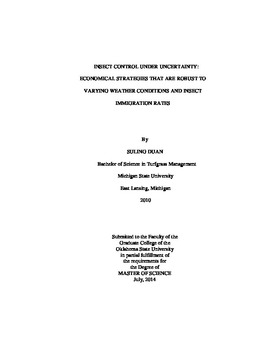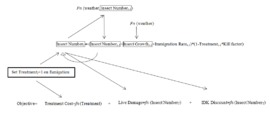| dc.description.abstract | Insect control is a key concern for handlers of grain and grain-based products during storage. Traditionally, storage managers treat insects one or more times per year to control insects on a pre-determined schedule with limited evaluation of overall pest population dynamics, which can cause both unnecessary treatment costs and more rapid evolution of insect resistance to the fumigants. Some IPM strategies, such as sampling in storage bins, are intended to gain more accurate information of insect population in order to apply more appropriate insect control treatments. But IPM strategies depend on sampling, and choosing the frequency and timing of sampling is difficult. Also, sampling is costly. Storage managers need guidelines to select economical insect control strategies.Here, an economic model is formulated and a simulation conducted to identify insect control strategies in wheat storage that are robust to changing weather conditions and alternative insect immigration rates. Costs of insect control include both treatment costs and costs of failing to control insects. Two different weather environments were considered, represented by Oklahoma City, Oklahoma, and Wichita, Kansas. The model shows how weather conditions, insect immigration rate and cost of insect control influence storage managers' insect management strategies. The insect control strategies considered include doing nothing, one or two routine fumigations, and fumigation based on sampling. Several sampling protocols were considered.Simulation results show that under most situations for which insect immigration rate was known, the optimal strategy (one that achieves lowest cost of insect control) was one or two fumigations. In contrast, when insect immigration rate is not known, a strategy of one fumigation plus sampling after that became dominant for Oklahoma City. For Wichita, no one strategy became dominant, because fumigation was not needed in every year in that environment. If cost of sampling was reduced by 50%, strategies using sampling became the least cost strategy under a greater range of scenarios. Also, if live insect discount was doubled, there was greater incentive to conduct more sampling after fumigating, to increase confidence that insects were, in fact, controlled. | |


